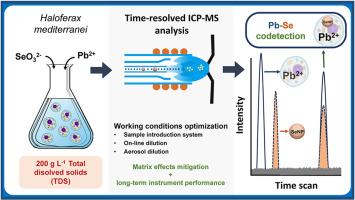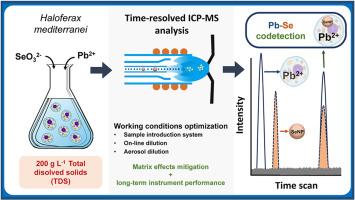Expanding time-resolved ICP-MS capabilities for characterizing cells and biogenic nanoparticles in hypersaline media
IF 6
2区 化学
Q1 CHEMISTRY, ANALYTICAL
引用次数: 0
Abstract
Background
The analysis of halophilic organisms using time-resolved inductively coupled plasma mass spectrometry (TRA ICP-MS) is challenging due to severe matrix effects caused by the high total dissolved solid concentration (200 g L−1) in their culture media. This work introduces a methodology that overcomes these issues by using Haloferax mediterranei as a model organism. The developed method preserves cell integrity and minimizes matrix effects, which enabled us to investigate Pb bioaccumulation and selenium nanoparticle (SeNP) formation in this archaeon by means of time-resolved inductively coupled plasma time-of-flight mass spectrometry (TRA ICP-TOFMS).
Results
To preserve H. mediterranei cells and mitigate matrix effects from high total dissolved solids, TRA ICP-MS working conditions were carefully optimized. A High-efficiency nebulizer and double-pass spray chamber were selected for sample introduction, as this configuration ensured high sensitivity and reduced matrix load into the plasma. Additionally, on-line sample dilution using a T-connector to achieve a 1:103 ratio and aerosol dilution were implemented to further reduce matrix load and mitigate cell osmotic stress. The method was used to monitor Pb bioaccumulation and detect biogenic SeNPs within individual cells using ICP-TOFMS. Lead and SeNPs detection limits were, respectively, 15 ag cell−1 and 42 nm. Single cell Pb uptake was highly heterogeneous, ranging from 20 to 300 ag cell−1 while SeNP sizes were between 47 and 73 nm. Co-detected events of Pb and Se suggests that SeNPs are located intracellularly rather than being expelled and freely suspended in the medium.
Significance
This methodology represents a significant advancement, as it is the first TRA ICP-MS approach to accurately analyze single halophilic cell in hypersaline media without the need for extensive sample preparation. This development allows for the quantitative assessment of heavy metal bioaccumulation and NP formation in extremophiles, thereby extending TRA ICP-MS applicability.


扩展时间分辨ICP-MS在高盐介质中表征细胞和生物纳米颗粒的能力
使用时间分辨电感耦合等离子体质谱(TRA ICP-MS)分析嗜盐生物是具有挑战性的,因为它们的培养基中总溶解固体浓度高(200g L-1)会引起严重的基质效应。这项工作介绍了一种方法,克服了这些问题,使用地中海卤黄作为模式生物。该方法保留了细胞的完整性,最大限度地减少了基质效应,使我们能够利用时间分辨电感耦合等离子体飞行时间质谱(TRA ICP-TOFMS)研究铅在该古菌中的生物积累和硒纳米颗粒(SeNP)的形成。结果为了保存地中海红颊鼠细胞,减轻高总溶解固体对基质的影响,对ICP-MS条件进行了优化。样品导入选择了高效雾化器和双通道喷雾室,因为这种配置确保了高灵敏度并减少了进入等离子体的基质负荷。此外,使用t型连接器在线稀释样品以达到1:103的比例,并进行气溶胶稀释,以进一步减少基质负荷并减轻细胞渗透胁迫。该方法采用ICP-TOFMS法监测Pb在单个细胞内的生物积累,并检测生物源性SeNPs。铅和SeNPs的检出限分别为15 ag cell-1和42 nm。单细胞对铅的摄取是高度不均匀的,从20到300 ag cell-1不等,而SeNP大小在47到73 nm之间。铅和硒的共同检测表明,SeNPs位于细胞内,而不是被排出并自由悬浮在介质中。该方法代表了一个重大的进步,因为它是第一个在高盐培养基中准确分析单个嗜盐细胞而不需要大量样品制备的TRA ICP-MS方法。这一发展允许对极端微生物中重金属的生物积累和NP形成进行定量评估,从而扩展了TRA ICP-MS的适用性。
本文章由计算机程序翻译,如有差异,请以英文原文为准。
求助全文
约1分钟内获得全文
求助全文
来源期刊

Analytica Chimica Acta
化学-分析化学
CiteScore
10.40
自引率
6.50%
发文量
1081
审稿时长
38 days
期刊介绍:
Analytica Chimica Acta has an open access mirror journal Analytica Chimica Acta: X, sharing the same aims and scope, editorial team, submission system and rigorous peer review.
Analytica Chimica Acta provides a forum for the rapid publication of original research, and critical, comprehensive reviews dealing with all aspects of fundamental and applied modern analytical chemistry. The journal welcomes the submission of research papers which report studies concerning the development of new and significant analytical methodologies. In determining the suitability of submitted articles for publication, particular scrutiny will be placed on the degree of novelty and impact of the research and the extent to which it adds to the existing body of knowledge in analytical chemistry.
 求助内容:
求助内容: 应助结果提醒方式:
应助结果提醒方式:


